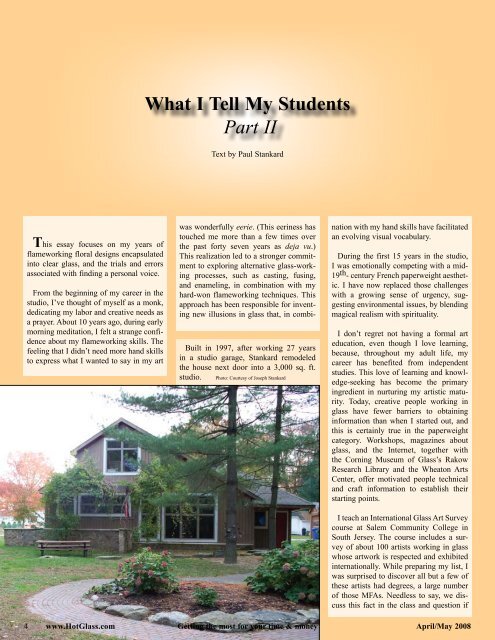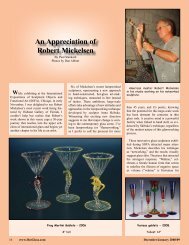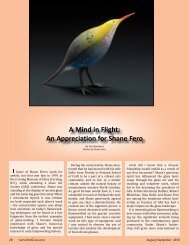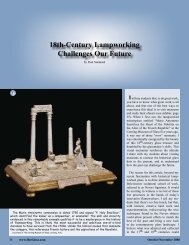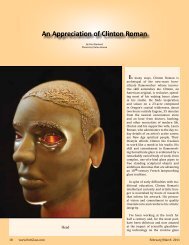What I Tell My Students Part II - Paul J Stankard
What I Tell My Students Part II - Paul J Stankard
What I Tell My Students Part II - Paul J Stankard
Create successful ePaper yourself
Turn your PDF publications into a flip-book with our unique Google optimized e-Paper software.
<strong>What</strong> I <strong>Tell</strong> <strong>My</strong> <strong>Students</strong><br />
<strong>Part</strong> <strong>II</strong><br />
Text by <strong>Paul</strong> <strong>Stankard</strong><br />
This essay focuses on my years of<br />
flameworking floral designs encapsulated<br />
into clear glass, and the trials and errors<br />
associated with finding a personal voice.<br />
From the beginning of my career in the<br />
studio, I’ve thought of myself as a monk,<br />
dedicating my labor and creative needs as<br />
a prayer. About 10 years ago, during early<br />
morning meditation, I felt a strange confidence<br />
about my flameworking skills. The<br />
feeling that I didn’t need more hand skills<br />
to express what I wanted to say in my art<br />
was wonderfully eerie. (This eeriness has<br />
touched me more than a few times over<br />
the past forty seven years as deja vu.)<br />
This realization led to a stronger commitment<br />
to exploring alternative glass-working<br />
processes, such as casting, fusing,<br />
and enameling, in combination with my<br />
hard-won flameworking techniques. This<br />
approach has been responsible for inventing<br />
new illusions in glass that, in combi-<br />
Built in 1997, after working 27 years<br />
in a studio garage, <strong>Stankard</strong> remodeled<br />
the house next door into a 3,000 sq. ft.<br />
studio. Photo: Courtesy of Joseph <strong>Stankard</strong><br />
nation with my hand skills have facilitated<br />
an evolving visual vocabulary.<br />
During the first 15 years in the studio,<br />
I was emotionally competing with a mid-<br />
19 th - century French paperweight aesthetic.<br />
I have now replaced those challenges<br />
with a growing sense of urgency, suggesting<br />
environmental issues, by blending<br />
magical realism with spirituality.<br />
I don’t regret not having a formal art<br />
education, even though I love learning,<br />
because, throughout my adult life, my<br />
career has benefited from independent<br />
studies. This love of learning and knowledge-seeking<br />
has become the primary<br />
ingredient in nurturing my artistic maturity.<br />
Today, creative people working in<br />
glass have fewer barriers to obtaining<br />
information than when I started out, and<br />
this is certainly true in the paperweight<br />
category. Workshops, magazines about<br />
glass, and the Internet, together with<br />
the Corning Museum of Glass’s Rakow<br />
Research Library and the Wheaton Arts<br />
Center, offer motivated people technical<br />
and craft information to establish their<br />
starting points.<br />
I teach an International Glass Art Survey<br />
course at Salem Community College in<br />
South Jersey. The course includes a survey<br />
of about 100 artists working in glass<br />
whose artwork is respected and exhibited<br />
internationally. While preparing my list, I<br />
was surprised to discover all but a few of<br />
these artists had degrees, a large number<br />
of those MFAs. Needless to say, we discuss<br />
this fact in the class and question if<br />
4 www.HotGlass.com Getting the most for your time & money<br />
April/May 2008
an associate’s degree in studio glass art<br />
is going to adequately prepare one for a<br />
career as a studio artist. I tell my students<br />
it generally takes five to 10 years of perseverance<br />
and determination after art school<br />
for talented people to attract attention<br />
through their work. Along this journey<br />
to develop skills and invent a personal<br />
vocabulary (personal vocabulary meaning<br />
being original), artists often develop a<br />
love-hate relationship with the glass.<br />
These observations lead to an interesting<br />
conversation with Henry Halem, a<br />
highly respected glass artist, author and<br />
educator. Henry commented, “<strong>Paul</strong>, your<br />
observation of why there are so many<br />
MFAs exhibiting is because the university,<br />
up till now, was the only place one could<br />
study the glass arts. I think for many an<br />
associate degree would be adequate for<br />
preparing one for a career in the glass<br />
arts. It’s really the quality of the program<br />
within a particular institution that prepares<br />
the student for their career, not the degree.<br />
Some are ready to go after two years but<br />
some take maybe three or four years of<br />
preparation.”<br />
Corning Museum of Glass’s Rakow Research Library enables people to research the<br />
past to build on the present. The dedicated staff is generous with their knowledge and<br />
ready to assist. Photo: Courtesy of Corning Museum of Glass<br />
Henry continues, “With the advent and<br />
growth of the public access school one<br />
can get an excellent education in glass<br />
and for probably a lot less money. <strong>What</strong><br />
you’re asking your students would be a<br />
good panel discussion for the Glass Art<br />
Society (GAS).”<br />
I took a different track because throughout<br />
my school years I struggled with undiagnosed<br />
dyslexia. This led me to making<br />
things, which I loved, and the happiest<br />
times in school were in wood shop and<br />
metal shop. After high school, I had the<br />
good fortune to attend Salem Vocational<br />
Technical Institute, now renamed Salem<br />
Community College. During my first visit<br />
to Salem, where I saw hand skills controlling<br />
the danger associated with glowing<br />
flames melting glass, I felt a peculiar<br />
attraction to flameworking. As a side note,<br />
while teaching at Penland, I told a few stories<br />
about playing with fire as a kid, and<br />
was nearly floored by others’ “firebug”<br />
stories.<br />
When I mentioned this to Robert<br />
Mickelsen, one of America’s leading<br />
flamework artists, he laughed and said<br />
most adolescents are curious about fire<br />
and have played with matches. He went<br />
April/May 2008<br />
Salem Community College campus, Carneys Point, NJ.<br />
Photo: courtesy of Salem Community College<br />
on to say, “I don’t think this attraction has<br />
affected glassblowing any more than other<br />
careers, although the topic would make a<br />
great discussion over a few beers after the<br />
flameworking conference.”<br />
I graduated from Salem in 1963 and<br />
went into industry, where I worked hard<br />
mastering techniques to fabricate scientific<br />
glass apparatus. It was during this<br />
industrial phase of my career that I discovered<br />
my creative side. Most days in the<br />
factory, I would dream of being creative<br />
and wanted to work fulltime making art.<br />
In 1969, when Patricia and I moved into<br />
our new house, my first priority was to set<br />
up a workbench in the corner of the utility<br />
room to work glass. It took a lot of sacrifice<br />
to buy materials and tools needed to<br />
work evenings and weekends, but eventually<br />
I was able to earn money producing<br />
giftware. After five months of making<br />
small animals, the work got boring and<br />
tedious. I realized I needed to be more<br />
creative, and started focusing on paperweights<br />
which were more ambitious.<br />
This new work was wonderfully exciting<br />
and the challenges associated with<br />
learning to flamework soft glass at the<br />
torch was like learning a new craft. Every<br />
aspect of this new endeavor offered inter-<br />
Getting the most for your time & money www.HotGlass.com 5
1971, stylized flower. The breakthrough<br />
for this piece was the center with upright<br />
stamens. Robin’s egg blue background<br />
was a popular color during <strong>Stankard</strong>’s<br />
part-time days. Photo: Courtesy of Joshua Steindler<br />
esting hurdles to overcome. Looking back,<br />
it’s sweet to remember what I was able to<br />
do with little equipment, and even though<br />
I benefited from 10 years of working with<br />
borosilicate glass, I loved the creative<br />
freedom and the wide-open possibilities<br />
of this new realm.<br />
While melting soda lime glass, there<br />
were times when the rod would pop and<br />
hot glass would fly around the utility<br />
room. It’s amazing I didn’t burn down<br />
our new house or get hurt, and I’m glad I<br />
didn’t give up on my dreams. The reason<br />
for the glass exploding was most likely<br />
poor annealing. The clear glass came<br />
from Kimble Glass Co. in Vineland, New<br />
Jersey, with the kind support of an executive<br />
named George Steer. George authorized<br />
a few old-timers in the hot shop to<br />
hand-pull the glass into three-foot lengths<br />
that were approximately one inch in diameter.<br />
This was in the ’60s, and Kimble had<br />
one of the few hand-shop furnace facilities<br />
left in South Jersey, which was once<br />
the center of our nation’s glass industry.<br />
I think back and marvel at how energized<br />
I was to learn paperweight making.<br />
The first paperweights had a variety of<br />
designs, from animals to flowers, and<br />
were influenced by the work of Charles<br />
Kaziun and Francis Whittemore, two contemporary<br />
paperweight makers from the<br />
’60s. Within a few months, I was focusing<br />
on flower blossoms and following a path<br />
for developing techniques to express my<br />
interests.<br />
Middle: 1971/2, stylized five-petal flower<br />
with upright stamens, spray of buds,<br />
curved stem with roots. The green glass is<br />
a mixture of yellow over blue over black.<br />
These personal techniques distinguished<br />
<strong>Stankard</strong>’s work.<br />
Bottom: 1973, floral motif interpreting<br />
native flower, Red Maid, suspended over<br />
white glass. Offers mottled red petals,<br />
green sequels, upright stamens, and rootlets<br />
off the stem. Photos: Courtesy of Joshua Steindler<br />
6 www.HotGlass.com Getting the most for your time & money<br />
April/May 2008
Inside the <strong>Stankard</strong> Studio, <strong>Paul</strong> with<br />
his talented staff. Background: Christine<br />
<strong>Stankard</strong> Kressley, <strong>Paul</strong>ine <strong>Stankard</strong> Iacovino<br />
Katherine <strong>Stankard</strong> Campbell. Foreground:<br />
David Graeber. Photo: Courtesy of Joseph <strong>Stankard</strong><br />
<strong>What</strong> has survived from that time period<br />
appears modest by today’s standards, but<br />
these early miniatures were, in fact, a<br />
major effort on my part and represent<br />
emotional success and sacrifice, because<br />
everything was a struggle.<br />
From the start, I divided the process into<br />
two tasks: first flameworking the colored<br />
glasses into a design called a set-up, then<br />
encapsulating it in clear glass. In the<br />
early days, developing the flower and the<br />
material preparation generally took a few<br />
nights.<br />
The next step was melting and balling<br />
up one end of a one-inch-diameter clear<br />
rod to approximately two inches in diameter.<br />
This turned out to be an exercise<br />
in bravery because, at times, the entire<br />
length of the glass rod would shatter and<br />
leave me feeling bewildered. I would hear<br />
a loud pop and the length of the rod would<br />
appear snow-white as it disintegrated into<br />
slivers within a split second. The glass<br />
was obviously not annealed, and most<br />
likely tempered, which would explain the<br />
ferocity of the rod exploding into pieces.<br />
In the days starting out, as I said earlier,<br />
everything was a struggle, and, after all<br />
these years, it’s interesting to note that I<br />
am still struggling. The beauty of discovering<br />
techniques while searching for ways<br />
around obstacles reinforces one’s style<br />
and is one of the most important aspects<br />
of artistic growth.<br />
Starting out, my equipment was homemade<br />
and I remember feeling guilty dismantling<br />
my daughter’s roller-skate to<br />
mount the wheels on a block of wood<br />
to use for rollers. <strong>My</strong> next challenge<br />
was how to support the glass rod over a<br />
Bunsen burner. Pat’s father helped out by<br />
welding angle iron together for a stand to<br />
rest the rods on. I would position the end<br />
of the balled-up glass rod over a Bunsen<br />
burner, and hand-rotate it over the flame<br />
<strong>Stankard</strong> fusing a stem on a lotus<br />
blossom. Photo: Courtesy of Joseph <strong>Stankard</strong><br />
April/May 2008<br />
Getting the most for your time & money www.HotGlass.com 7
<strong>Stankard</strong> sealing the botanical components<br />
into a design on the gas-fired hot<br />
plate. Photo: Courtesy of Joseph <strong>Stankard</strong><br />
to keep it heated evenly and reasonably<br />
true.<br />
<strong>My</strong> first few paperweights were formed<br />
by gravity and a carbon paddle, and<br />
it didn’t take long to make a cherrywood<br />
mold or cup to shape the glass in.<br />
This idea came from watching furnace<br />
glassblowing demonstrations at Wheaton<br />
Village, now renamed Wheaton Arts. I<br />
remember how excited I was to bring this<br />
furnace working technique into the utility<br />
room to solve my shaping problems at the<br />
flameworking bench.<br />
After the set-up was made, I balled<br />
up the top half of what would become a<br />
paperweight and rested it on the stand.<br />
I then balled up the bottom section and,<br />
with tweezers, picked up the colored glass<br />
inclusion and dropped it on the superheated<br />
surface. With a combination of<br />
dropping and tapping the colored glass<br />
design with tweezers onto the hot surface,<br />
I learned how to get a good seal.<br />
Reheating the top half in my right hand<br />
while splashing the bottom half with my<br />
left hand to keep the glass hot was a good<br />
trick. When the glass was hot enough,<br />
“Whack”—I pushed the two sections<br />
together and hoped for the best. The hotter<br />
the top half-section was, the softer and<br />
better the seal would be, meaning fewer<br />
trapped air bubbles. I used the one-inch<br />
glass rod as a pontil while shaping the bottom.<br />
Next, I stuck up the bottom section<br />
with a Pyrex rod and rounded the top to<br />
finish the piece.<br />
By the time the paperweight was<br />
knocked off the Pyrex pontil into the oven<br />
to anneal, I was on a creative high unlike<br />
anything I experienced in industry and<br />
generally felt drained. <strong>What</strong> was magi-<br />
Middle:<br />
Removing the clear glass gob from the<br />
kiln by sticking up the glass with a pontil<br />
to be reheated.<br />
Bottom:<br />
Pickup. Dropping preheated clear glass<br />
onto preheated colored glass design for<br />
encapsulation. Photos: Courtesy of Joseph <strong>Stankard</strong><br />
April/May 2008
cal then and still is beautiful today is the<br />
orange glow in the clear glass from the<br />
design form before it goes into the oven<br />
to be annealed.<br />
At this stage of the game, sharing experiences<br />
and offering encouragement to<br />
young people is an important counterpoint<br />
to my studio work. When I was young,<br />
I would hear my mom say, “If you want<br />
to be successful in life, you have to pay<br />
attention to your knitting.” I’ve taken my<br />
mom’s folksy advice and, when thinking<br />
of her words, smile, knowing that my<br />
disciplined focus has complemented my<br />
journey.<br />
Today in my studio, developing new<br />
designs can take days, months, and—in<br />
some cases—years, as I search for ways<br />
to get it right. “Getting it right” is my way<br />
of saying “making the work personal and<br />
pursing excellence in workmanship.” I<br />
start my designs by focusing on a plant’s<br />
characteristics and the folklore associated<br />
with it. Next is to select the colored glasses.<br />
I often experiment with powder-glass<br />
blends to melt and overlay on small diameter<br />
rods used in material preparation.<br />
The goal is to sculpt designs in glass<br />
that suggest truth to nature, giving the<br />
flameworked flowers organic credibility<br />
or botanical intelligence. Taking advantage<br />
of a life-long interest in flowers and<br />
walking the woods must have somehow<br />
helped my work. That transfer of emotional<br />
energy and love of nature into inorganic<br />
material—glass—is the magical essence<br />
of art-making.<br />
Once the design is picked up from the plate, the surface is fire polished in the glory hole.<br />
Photo: Courtesy of Joseph <strong>Stankard</strong><br />
<strong>Stankard</strong>'s work bench displaying tools for encapsulating, shaping, and finishing a piece.<br />
Photo: Courtesy of Carol Bates<br />
In my spacious studio, I have the advantage<br />
of four art-literate assistants who are<br />
all dedicated to helping me express my<br />
vision. With this help, I’m able to be more<br />
ambitious with my creative efforts.<br />
When I started making paperweights<br />
in the ’60s, a major challenge was finding<br />
suitable clear and colored glasses to<br />
flamework. Today, the glass community<br />
is fortunate to benefit from a proliferation<br />
of manufacturing companies producing<br />
compatible clear and colored glass. I use<br />
Schott S8 encapsulation glass, which is<br />
a high-quality soda lime glass distributed<br />
by Glass Brokers of Duryea, PA.<br />
<strong>My</strong> colored rods come from a growing<br />
number of companies producing a wide<br />
selection of colors. In fact, I just recently<br />
April/May 2008<br />
Getting the most for your time & money www.HotGlass.com 9
learned that a leading borosilicate manufacturer,<br />
Northstar Glassworks in Oregon,<br />
is producing colored soft glasses with a<br />
coefficient of expansion of 104, matching<br />
Schott S8 glass, among others.<br />
It’s strange realizing I’ve been huddled<br />
over a Carlisle CC bench burner my entire<br />
career, which I use to redraw 1-1/2 inch<br />
diameter 10-inch-long stock into 1/4 inch<br />
glass rods. Now, most companies are producing<br />
the smaller rods for flameworkers,<br />
which is making my task easier. These<br />
small-diameter rods used to craft botanical<br />
components are worked in an oxygenrich<br />
gas flame with simple hand tools.<br />
Once the components are flameworked at<br />
the benches, they’re transferred onto a hot<br />
plate to keep warm and are then fused into<br />
the design. When the design is constructed,<br />
it’s transferred to what I call a pick-up<br />
plate with a metal cup around it. The floral<br />
design is kept at 965 degrees Fahrenheit<br />
to prevent the clear molten glass from<br />
shocking and cracking the design when it<br />
is dropped on.<br />
I’ve spent more time and emotional<br />
energy inventing illusions for floral<br />
designs than mastering the craft of encapsulating<br />
the designs. Over the years, I’ve<br />
learned how to melt and work colors in<br />
and around clear crystal to suggest hollows.<br />
As an example, if I am making a<br />
morning glory, I’ll overlay the blue for<br />
the blossom over clear glass and flare the<br />
end, so that, when the hot soft glass drops<br />
onto the glass morning glory, the crystal<br />
becomes negative space, suggesting the<br />
flower’s hollow throat.<br />
Penland’s Nocturnal Bloom glass assemblage.<br />
8 1/4 x 7 3/4 x 4 3/4 in. From collection<br />
of Mike and Annie Belkin.<br />
Photo: courtesy of Douglas Schaible<br />
10 www.HotGlass.com Getting the most for your time & money<br />
April/May 2008
I bead the end of the metal five-foot<br />
pontil with clear glass to stick up the gob<br />
that’s preheating in the oven at 1,000<br />
degrees Fahrenheit. When the gob is on<br />
the end of the pontil, my assistant melts it<br />
soft in the glory hole. Once the glass has<br />
been heated and balls itself up, I guide it<br />
into the collar, sometimes called a cup,<br />
which is preheated in the pick-up oven.<br />
While this motion is in play, I activate<br />
the suction pump under the oven to aid the<br />
pick-up and, in a fraction of a second, the<br />
colored glass is captured and surrounded<br />
by clear crystal. I then turn off the pump<br />
and blow compressed air onto the hot<br />
glass and pontil to cool it down, so I can<br />
control it as it’s lifted out of the collar.<br />
(From left to right) 3 1/2 in. lilac bouquet<br />
orb, 8 in. floating bouquet orb, 5 1/2<br />
in. wildflower bouquet orb with swarming<br />
bees. Photo: courtesy of Douglas Schaible<br />
Now, with the colored glass design<br />
sealed into the crystal, my assistant heats<br />
up glass for the bottom half of the paperweight<br />
and I carefully push the two sections<br />
together. When the required volume<br />
is added, I remove one pontil from the<br />
paperweight to orient the piece and shape<br />
it into a sphere with a graphite cup, or<br />
press it into a graphite mold to shape into<br />
a cube. Once it’s shaped and before it goes<br />
into the annealing oven, it’s a wonderful<br />
feeling to experience the beauty of the<br />
glowing design suspended in the clear<br />
glass. This effort, glowing with beauty,<br />
is poetry going into the oven and I get a<br />
positive feeling anticipating the end of the<br />
40-hour annealing cycle. Unfortunately,<br />
after scrutiny, sometimes the magic evaporates<br />
and the piece is rejected.<br />
Today, I continue to do my work, but<br />
I’m also mentoring my staff to develop<br />
their own works under the <strong>Stankard</strong> Studio<br />
banner. We’ve established <strong>Stankard</strong> Studio<br />
to give my assistants—Christine <strong>Stankard</strong><br />
Kressley, <strong>Paul</strong>ine <strong>Stankard</strong> Iacovino,<br />
Katherine <strong>Stankard</strong> Campbell, and David<br />
Graeber—the opportunity to do their own<br />
work. In addition to helping me, they are<br />
creating their own designs. I get a sense<br />
of pride knowing that their work is personal<br />
to them and respected among glass<br />
enthusiasts.<br />
<strong>My</strong> hope is for them to find fulfillment<br />
in their careers, just as I have. <strong>What</strong> we’re<br />
doing is recording the artistic sensibilities<br />
of our time period. Ideally, these best<br />
efforts will advance skill and creative<br />
energy, exemplifying flameworked beauty<br />
into the future, so others can build on our<br />
efforts, much as we built on the efforts of<br />
those who came before us.<br />
Publisher’s Notes<br />
<strong>Paul</strong> <strong>Stankard</strong> has earned an international<br />
reputation for his flameworked glass<br />
art. His most recent book, No Green<br />
Berries or Leaves: The Creative Journey<br />
of an Artist in Glass (available at www.<br />
mwpubco.com) is an inspiring read for all<br />
who want to be, as <strong>Stankard</strong> says, “on the<br />
creative side in glass.”<br />
(This is the second part of a twopart<br />
essay. Comments are welcome at<br />
pstank4955@aol.com.) (Cover photo: Courtesy of<br />
John Healey)<br />
April/May 2008<br />
Getting the most for your time & money www.HotGlass.com 11


